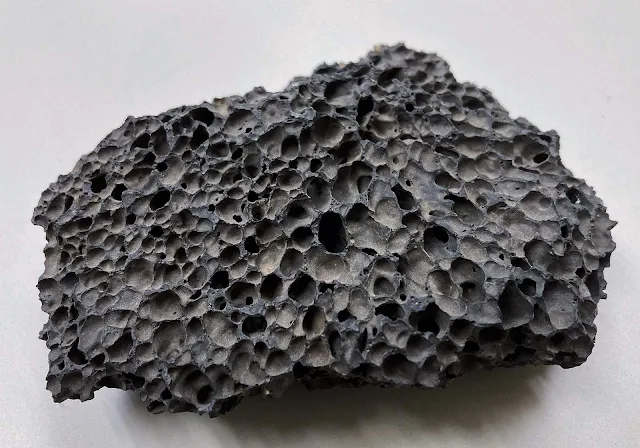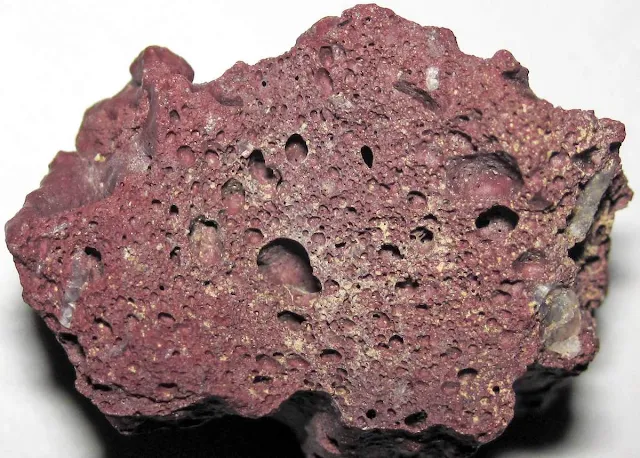Scoria: Properties, Uses, Types of Scoria
Scoria is a highly vesicular pyroclastic rock, meaning it's formed from volcanic fragments ejected during an eruption. It's highly vesicular, meaning it has numerous holes or cavities called vesicles, which give it a sponge-like texture. Scoria is typically dark-colored, ranging from black or brown to reddish-brown.
It's typically brown, black, or purplish-red and typically has a composition similar to basalt or andesite.
The word "scoria" comes from the ancient Greek word skōria (σκωρία) literally translates to "rust" or "dross", referring to the oxidized residue left behind after smelting metals.
Scoria's ability to float on water depends on its vesicularity and density. Scoria can float in some cases with large, interconnected vesicles, but many types are denser and sink.
Scoria Key Features
- Category: Pyroclastic rock
- Texture: Highly vesicular, with many holes or cavities
- Composition: Primarily volcanic glass, with possible mineral inclusions
- Color: Black, brown, purplish-red (usually dark)
- Hardness: Moderately hard (3-5 on Mohs scale)
 |
| Scoria, Martin, Idaho. Photo: B. Domangue |
Scoria Formation
The key to scoria's formation is gas. Magma within a volcano contains dissolved gases like water vapor and carbon dioxide. When the magma erupts and the pressure drops, these gases come out of solution, forming bubbles within the molten rock. If the rock cools quickly before the bubbles escape, they get trapped inside, resulting in the characteristic bubbly texture of scoria.
Magmatic composition: Scoria typically forms from basaltic or andesitic magma, characterized by high silica content (45-57%) and low viscosity.
Gas exsolution: As magma ascends towards the surface, pressure drops, causing dissolved gases (mainly water vapor and CO₂) to come out of solution.
Vesiculation: These exsolving gases form bubbles within the magma, leading to vesiculation. The size and distribution of vesicles depend on factors like magma composition, gas content, and cooling rate.
Rapid cooling: Vesicular magma cools rapidly upon contact with the atmosphere or fragmentation during explosive eruptions. This rapid cooling traps gas bubbles within the solidified rock, creating the characteristic vesicular texture of scoria.
Scoria Properties
Scoria Mineral Composition: Scoria's main mineral is volcanic glass, formed from rapidly cooled lava. It can also contain crystals like plagioclase feldspar, pyroxene (often green or brown), and olivine (greenish). These minerals may be present as tiny crystals within the glass or as larger phenocrysts visible to the naked eye. These crystalline minerals depend on the original magma's composition.
Texture: Scoria's most striking feature is its vesicular texture, meaning it's riddled with holes or cavities called vesicles.
Color: Scoria typically comes in dark shades like black, brown, and purplish-red. The color is influenced by the composition of the volcanic glass and the presence of mineral inclusions.
Hardness: Scoria's hardness varies depending on its density and composition. Generally, it falls within the 3-5 range on the Mohs scale of mineral hardness. This means it can be scratched by a steel knife but not by a fingernail.
Density: Varies depending on the degree of vesicularity. Generally denser than pumice (another vesicular rock) due to thicker vesicle walls and denser volcanic glass. Scoria typically sinks in water, while pumice floats.
Porosity and permeability: The high number of vesicles makes scoria very porous and permeable, allowing for efficient fluid flow and gas exchange. This makes it suitable for applications like drainage and filtration.
Types of Scoria
Scoria can be classified based on various factors like vesicle size, morphology, and origin. Common types include:
 |
| Cinder |
Cinder: This is the most common type, typically found in cinder cones formed by explosive eruptions. Cinder scoria is fine-grained, with small, elongated vesicles formed when lava fragments solidify in the air. Think of it as tiny, bubbly pebbles.
Lava flow scoria: This type forms within or on the surface of lava flows. The vesicles can be more varied in size and shape depending on the cooling rate and gas content. Imagine it as larger, chunkier pieces of scoria with diverse bubble patterns.
Blocky scoria: This type consists of large, blocky fragments of lava with vesicles, ejected during violent eruptions. Think of it as massive chunks of scoria, often with jagged edges and irregular cavities.
A'ā scoria: This type is specific to a'ā lava flows, which are characterized by thick, viscous lava with a blocky, rubbly surface. A'ā scoria tends to be denser and more massive than other types, with vesicles concentrated near the surface.
 |
| Reddish Scoria. The reddish-brown coloration is from weathering of mafic minerals |
Scoria Uses
Scoria's unique properties make it a surprisingly versatile material with a wide range of uses across various fields. Here are some of its most common applications:
Construction
- Lightweight concrete: Crushed scoria can be used as an aggregate in lightweight concrete blocks and panels, making them easier to handle and reducing the overall weight of structures.
- Building insulation: Scoria's porous nature makes it a good insulator, helping to regulate temperature and reduce energy costs in buildings.
- Roofing granules: Reddish-brown scoria is sometimes used as roofing granules, providing a decorative and protective layer.
Landscaping
- Drainage material: Scoria's porosity and permeability make it ideal for drainage applications, such as garden beds, walkways, and French drains. It helps prevent waterlogging and improves soil aeration.
- Mulch: Scoria can be used as a decorative mulch around plants, retaining moisture and suppressing weeds while adding visual interest.
- Rock gardens and pathways: Scoria's unique texture and colors can be used to create visually appealing rock gardens and pathways, adding a natural element to landscaping projects.
Other applications
- Filtration: Scoria's ability to trap sediment and pollutants makes it suitable for filtering water and wastewater.
- Abrasive: Crushed scoria can be used for sandblasting and polishing due to its hardness and irregular surface.
- Barbecue and sauna stones: Scoria's heat retention properties make it a good choice for barbecue grills and sauna stones.
- Decorative purposes: Scoria's unique texture and colors can be used in various decorative applications, such as vases, sculptures, and garden art.
 |
| Tuff moai with red scoria pukao on its head |
Where is Scoria Found
Around and on Volcanoes: Scoria is most commonly found near active and dormant volcanoes, particularly those with explosive eruptions. You'll often see it around volcanic vents, craters, and lava flows.
Cinder Cone Fields: Cinder cones are small, steep-sided volcanoes formed by the accumulation of volcanic ash, lapilli (small rock fragments), and scoria. These fields can be excellent places to find large deposits of scoria.
Ancient Lava Flows: Even long after a volcanic eruption, scoria can remain scattered on the surface of ancient lava flows. Over time, these flows may be weathered and eroded, but the scoria's durability often makes it stand out.
Specific Examples:
Sunset Crater, Arizona: This cinder cone near Flagstaff, Arizona, is a popular tourist destination and a prime example of where to find scoria. The cone itself is composed primarily of scoria, and the surrounding area is littered with pieces of various sizes.
The San Francisco Volcanic Field, Arizona: This vast field contains over 600 cinder cones, making it a treasure trove of scoria. Visiting this area allows you to see scoria in different forms and settings.
Mount Fuji, Japan: Even on iconic mountains like Mount Fuji, you can find scoria. The upper slopes of the volcano are home to several cinder cones and lava flows containing this volcanic rock.
Mars: Interestingly, scoria has also been found on Mars! The Spirit rover discovered deposits of scoria on the Martian surface, providing valuable insights into the planet's volcanic history.
Read also:
Dunite - Formation, Composition and Properties
Gabbro - What is a Gabbro?
What Is Granite And How Is It Formed?

%20(1).webp)






